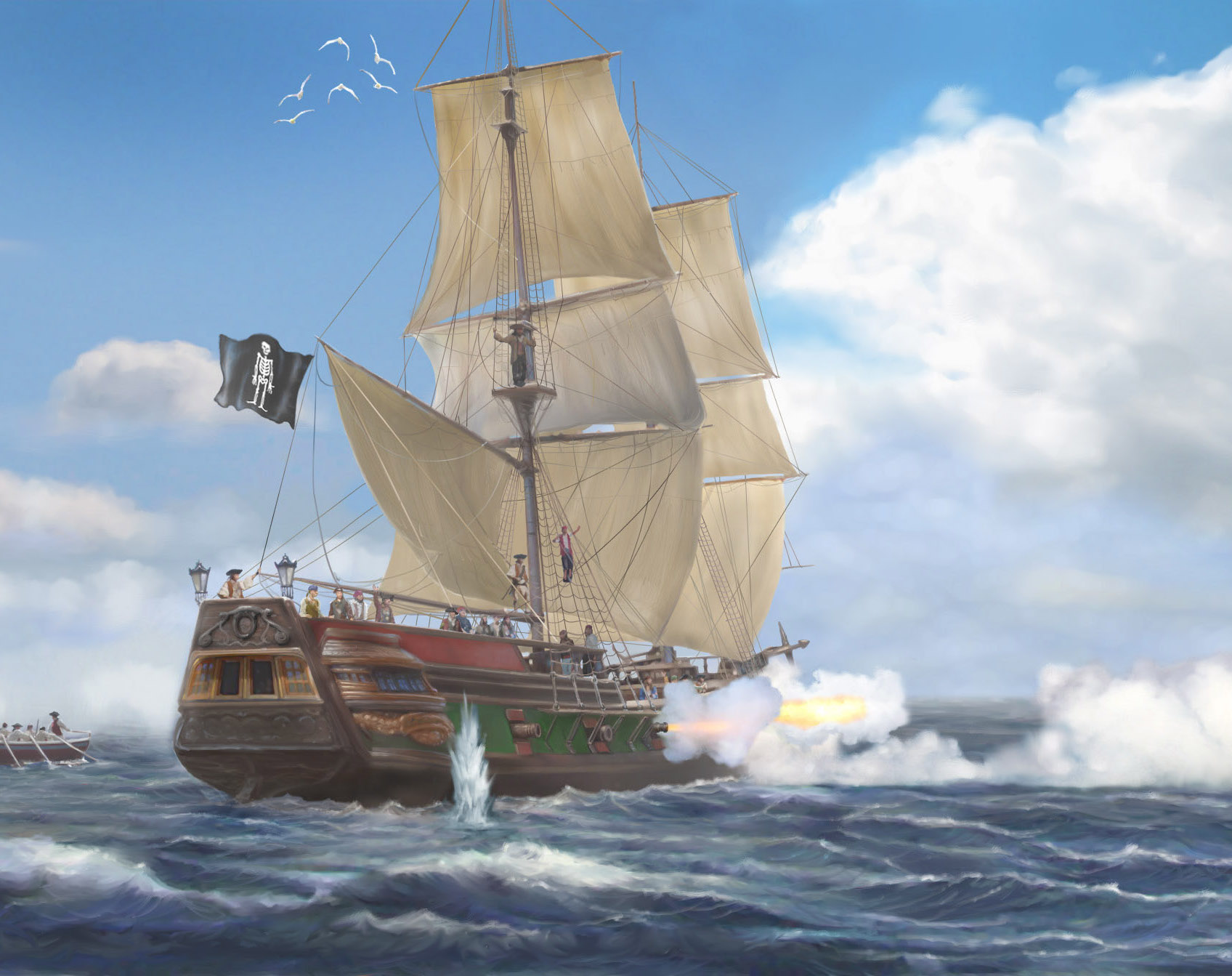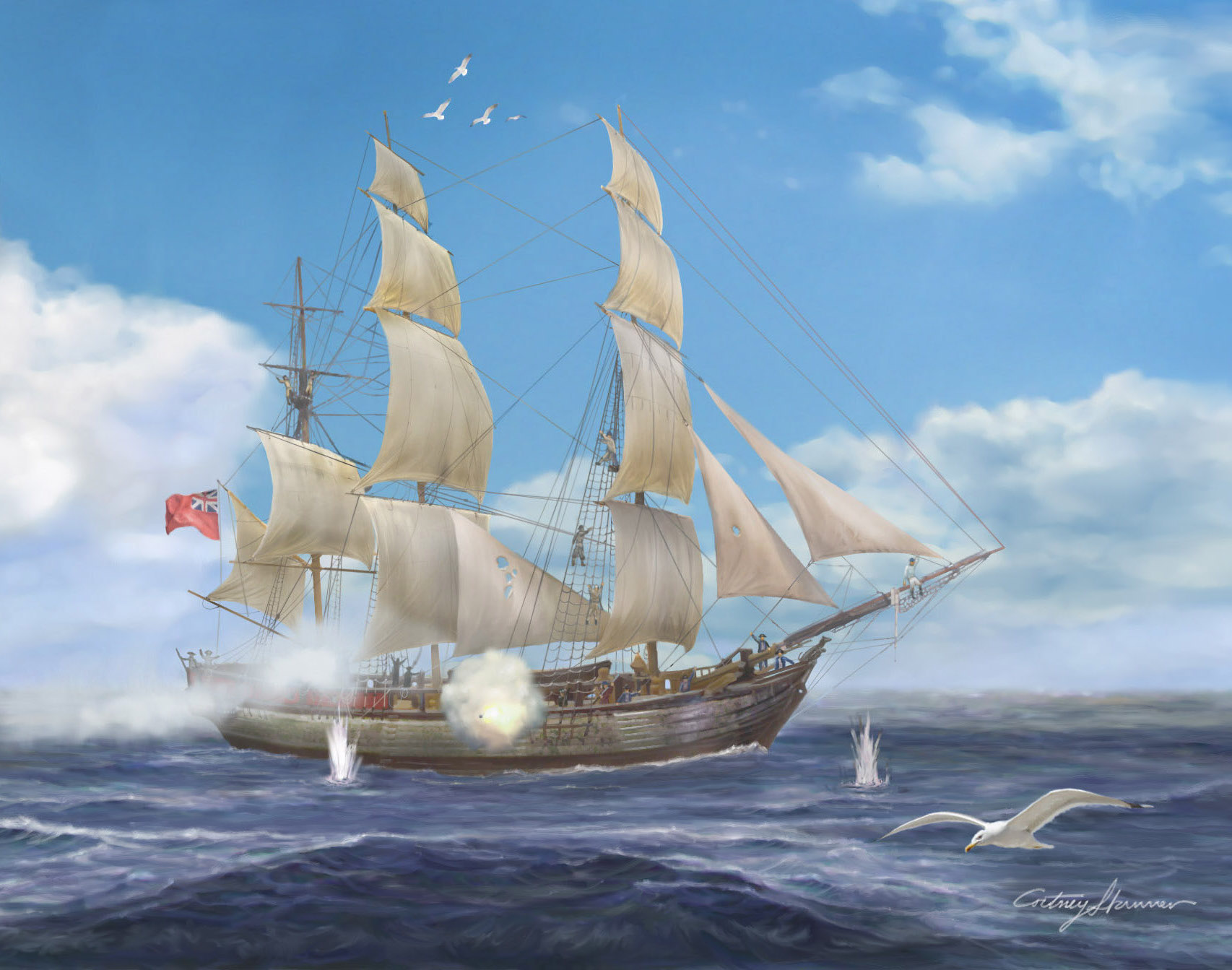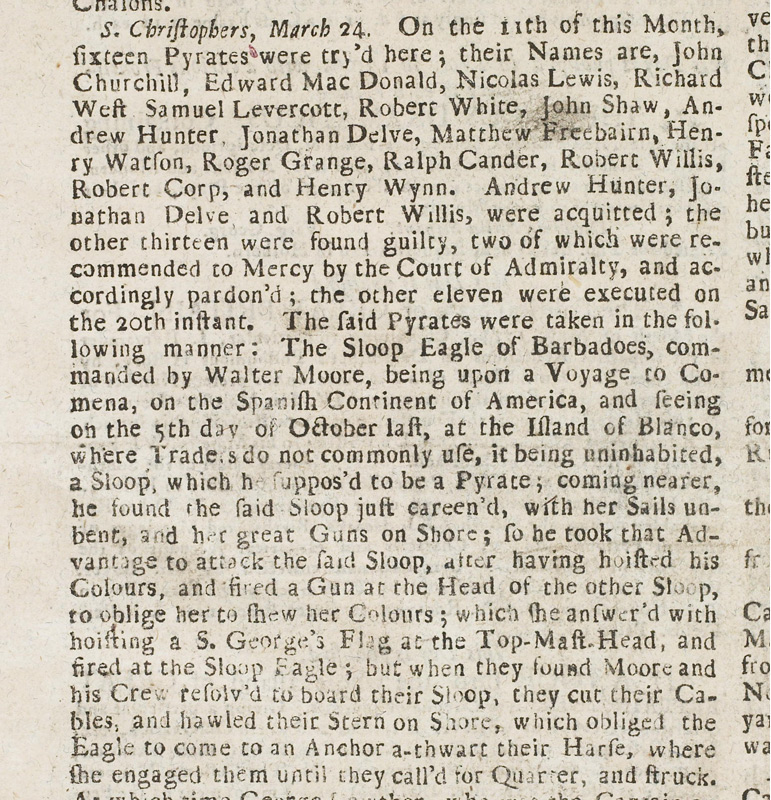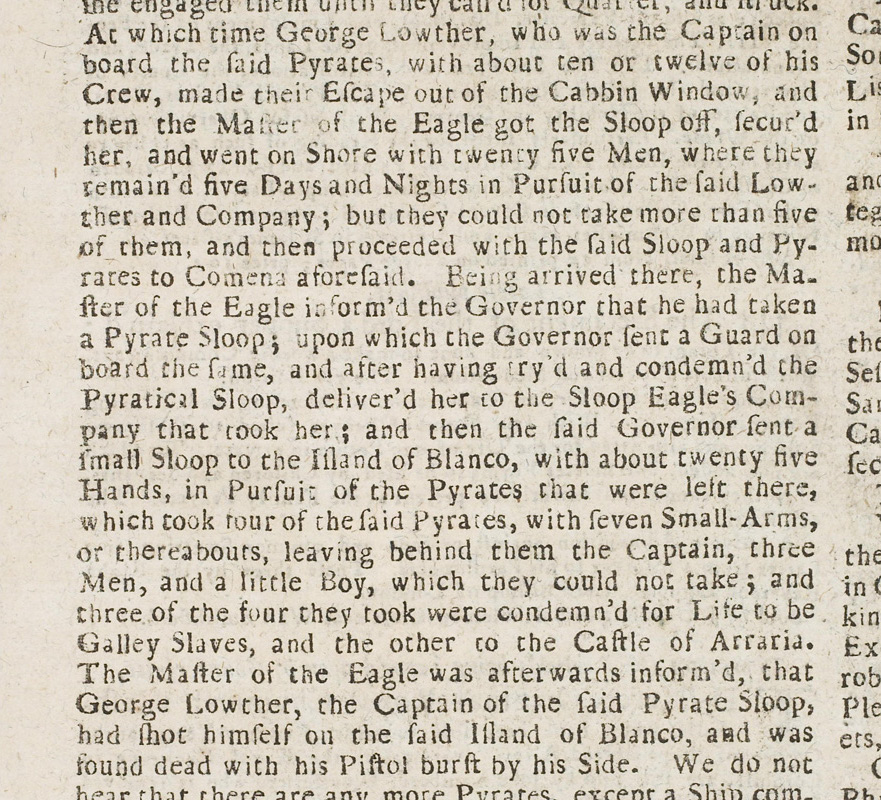Fighting Pirates in the Caribbean on January 10, 1722
The following is taken from “Pirates of the New England Coast” by George Francis Dow and John Henry Edmonds, 1923. Buy this book.
On the 10th of January 1722, the good ship “Greyhound” of Boston in the Massachusetts Bay, Benjamin Edwards, commander, was homeward bound. She was loaded with logwood and only one day out from the coast of Honduras where the crew had been worked hard for several weeks loading the many boatloads of heavy, thorny-growthed, blood-red wood. Early in the morning the lookout had sighted a ship headed toward them and while not plantation built she attracted no particular attention until it was seen that her course was slightly changed to conform to that of the “Greyhound,” or rather, it would seem, to intersect the course on which the “Greyhound” was sailing. As the ship drew nearer, a long look through the perspective revealed a heavily-manned vessel of English build and Captain Edwards thought it best to order all hands on deck. Soon the stranger ran up a black flag having a skeleton on it and fired a gun for the “Greyhound” to bring to.
West India waters had been plagued for many years by piratical gentry and the Boston captain had heard many terrifying tales of their barbarous cruelties to masters and seamen but he was a dogged type of man and so at once prepared to defend his ship. The pirate edged down a bit and shortly gave the “Greyhound” a broadside of eight guns which Captain Edwards bravely returned and for nearly an hour the give and take continued at long gunshot without much damage to either vessel.
Finding that the pirate was more heavily armed than the “Greyhound,” and her decks showing many men, Captain Edwards began to reckon the consequences of a too stubborn resistance, for it seemed likely that eventually he must surrender, barring, of course, lucky chance shot from his guns that might cut down a mast on the pirate ship. At last he ordered his ensign to be struck and hove to. Two boatloads of armed men soon came aboard and searched the ship for anything of value. The loot was not great for the New England logwood ships had little opportunity for trade or barter and the disappointment of the pirate crews was soon spit out on the men. Whenever one came within reach of the cutlass of a pirate he would receive a swinging slash across shoulders or arms, or perhaps, a blow on the head with the flat of the blade that would fell him half-senseless to the deck. By way of diversion two of the unoffending sailors were triced up at the foot of the mainmast and lashed until the blood ran from their backs. Captain Edwards and his men were then ordered into the boats and sent on board the pirate ship and the “Greyhound” was set on fire.
The rogue proved to be the “Happy Delivery,” commanded by Capt. George Lowther and manned by a strange assortment of English sailors and soldiers with a sprinkling of New England men. As soon as the men from the “Greyhound” reached her deck they were given a mug of rum and invited to join the pirate crew. This was habitually done at that time by these outlaws and frequently made a nimble sailor would be forced and compelled to serve with the pirates against his will. The first mate of the “Greyhound” was Charles Harris, born in London, England, then about twenty-four years old, and a man who understood navigation (which was a major ability for any seaman and was in fact not common among sailors as a rule) He, with four others, Christopher Atwell, Henry Smith, Joseph Willis and David Lindsay, was forced (ie kidnapped) and Captain Edwards and the rest of his crew, with other captured men, were put on board another logwood vessel and permitted to make the best of their way home.
The following is taken from “A General History of Pyrates” by Captain Charles Johnson, 1724.
The 10th of January, the pyrates came into the Bay (Bay of Honduras) and fell upon a ship of 200 Tuns, called the Greyhound, Benjamin Edwards Commander, belonging to Boston. Lowther hoisted his pyratical Colours and fired a Gun for the Greyhound to bring to, which she refusing, the Happy Delivery (the name of the Pyrate, Lowther’s ship) edg’d down, and gave her a Broadside (the firing of all guns on one side of a ship at the same time), which was returned by Captain Edwards very bravely, and the Engagement held for an hour; but Captain Edwards, finding the Pyrate too strong for him, and fearing the Consequence of too obstinate a Resistance against those lawless Fellows, order’d his Ensign to be struck. The Pyrates’ Boat came aboard, and not only rifled the Ship, but whipp’d, beat, and cut the Men in a cruel Manner, turned them aboard their own Ship, and then set Fire to theirs. (ie the crew were brought aboard the Delivery and the Greyhound burnt)
Press accounts of the day – all spellings match the original newspaper articles.
The following is taken from the April 30, 1722 issue of the Boston News-Letter.
On the 10th of January last in the Bay of Honduras, Capt. Benjamin Eewas of this Port, was attacked by Captain Lowder the Pirate, who after a stout resistence was taken and barbarously handled by them, they burnt his ship and forced away the following men, Christopher Atwell, Charles Harris, Henry Smith, Joseph Willis and David Lindsay of which (Life Permitted) we design a fuller Account in our next.
The following is taken from the May 7, 1722 issue of the Boston News-Letter.
Boston, on the 10th of January last the ship Gray.Hound of this Port Capt. Benjamin Edwards Commander, in the Bay of Honduras, was Attacked by the Bumper Gally, then called the Happy delivery a ship of 250 Tuns, having on Board 80 or 90 Pirates, commanded by George Lowder. The said Pirate forced away from Capt. Edwards the following Mariners, viz. Christopher Atwell Chief Mate aged about 26, much Pock Broken, born in the West of England. Charles Harris Second Mate, aged about 25, small stature, born in London. Henry Smith Carpenter, aged about 25 years, born in Boston. Joseph Willis aged 18 years, Apprentice to the Capt. born in London. David Lindsay aged 50 years born in Scotland, and they burnt his Ship.
What became of pirate George Lowther?
The answer to that question is something straight out of a Disney movie. I’ll let you discover it as Captain Edwards might have himself, by reading this original article from the June 13, 1724 issue of a London newspaper called The Post Boy. It is the oldest item in my collection.





